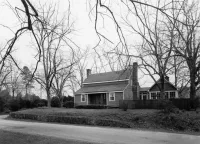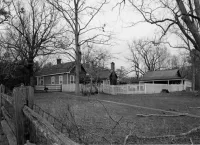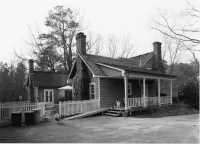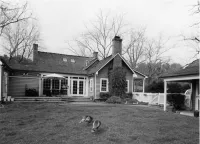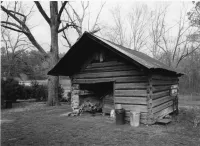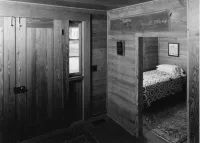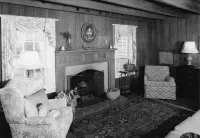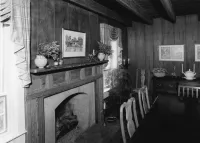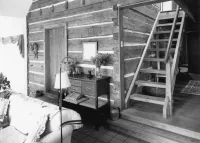Share what you know,
and discover more.
Share what you know,
and discover more.
Apr 18, 1997
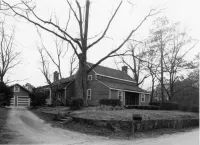
-

- Charmaine Bantugan
National Register of Historic Places - Simeon and Jane Rucker Log House
Statement of Significance: The Simeon and Jane Rucker Log House is significance in terms of architecture for its log construction, its vernacular form and plan, and its age. The Rucker Log House is an excellent intact example of early 19th-century log house construction in north Georgia. Characteristic architectural features include massive hewn logs, square notching, and weatherboard siding rather than chinking. Hewn logs like those in the Rucker House are typically found in log houses in the northern areas of Georgia; round-log construction predominates in South Georgia. Square notching like that in the Rucker house is less common than half-dovetail notching like that found in the Rucker smokehouse. Many log houses, especially in north Georgia, were historically weatherboarded rather than chinked. Stone-and-brick chimneys are indigenous to north Georgia where surface rock is more plentiful. Log houses like the Rucker house once were quite common in this area but now are extremely rare. Indeed, less than a dozen log houses in Georgia are currently individually listed in the National Register, and none of these is in the metropolitan Atlanta area. Only four predate the Rucker house, the oldest by less than ten years (several have estimated dates of construction and may not in fact predate this house). The historic smokehouse in the rear yard also is significant architecturally for its log construction which features half-hewn logs and the more common (in north Georgia) half-dovetail corner notching. The Rucker Log House also is architecturally significant as an excellent example of the relatively common hall-parlor type of vernacular house in Georgia. This house type features a rectangular plan with two unequal rooms and no hallway and a side-gabled roof with exterior end chimneys. Most houses of this type are one story high, although one-and-a-half story variants are not uncommon. Most are wood-framed rather than log. The added front shed rooms and porch typify the way in which hall-parlor and other types of houses were enlarged historically. Given the fact that the Rucker Log House has been continuously occupied for more than a century and a half, it retains a remarkable degree of historic architectural integrity. The principal architectural components of the house-its log construction and hall-parlor plan-form--remain virtually unchanged. Most architectural elements which had to be replaced due to deterioration, such as the windows, some of the siding, and the roofing, were replaced in kind. Although the modern addition is large, it stands to the rear of the historic house and replicates at least part of an earlier addition; it also accommodates modern conveniences like bathrooms and the kitchen so that the historic portion of the house could be more authentically restored. Exploration and Settlement The Rucker Log House is significant in terms of exploration and settlement for its direct historical associations with the first wave of Euro-American settlement in this part of the state. This region was opened to white settlement after 1832 when the State of Georgia with Federal assistance seized Cherokee Indian lands (by 1831) and distributed them to white settlers through a land lottery (1832). Following a typical westward migration pattern, Simeon and Jane Rucker moved to this location from further east in Georgia (possibly after a short sojourn in Alabama) and built this log house for themselves and their family, probably as early as 1833 according to deed records, but certainly by 1835 when other records indicate that they were purchasing domestic provisions and agricultural supplies at a nearby country store. John Rucker, like many pioneers, was a farmer, growing cash crops like cotton and practicing subsistence farming. Over the years he acquired extensive landholdings in the Crabapple area. John and Jane's children became locally prominent in agriculture, agri-business, newspaper publishing, and politics. Their son John narrowly escaped capture by Union troops during the Civil War by hiding out on his father's property; fearing capture, he inscribed his name and the date August 3, 1864, on a wooden plank in the house (still present) so that his family and friends might know when he was last in the house. John later inherited the family homeplace after his father died in 1881 and owned it until his death in 1918. His daughter owned the property until 1941. Log houses and hall-parlor houses like the Rucker's were common on the early 19th-century Georgia frontier. They represent the kind of houses most frequently built by pioneering settlers. Yet relatively few frontier-era houses like the Rucker's have survived, especially in the Atlanta metropolitan area. Less than 1% of all the extant surveyed historic houses in Georgia date from this frontier era (1830s) or earlier. Also contributing to the value of this property as an expression of 19th-century frontier life are the extant smokehouse and the known locations of several former domestic outbuildings associated with the house.
National Register of Historic Places - Simeon and Jane Rucker Log House
Statement of Significance: The Simeon and Jane Rucker Log House is significance in terms of architecture for its log construction, its vernacular form and plan, and its age. The Rucker Log House is an excellent intact example of early 19th-century log house construction in north Georgia. Characteristic architectural features include massive hewn logs, square notching, and weatherboard siding rather than chinking. Hewn logs like those in the Rucker House are typically found in log houses in the northern areas of Georgia; round-log construction predominates in South Georgia. Square notching like that in the Rucker house is less common than half-dovetail notching like that found in the Rucker smokehouse. Many log houses, especially in north Georgia, were historically weatherboarded rather than chinked. Stone-and-brick chimneys are indigenous to north Georgia where surface rock is more plentiful. Log houses like the Rucker house once were quite common in this area but now are extremely rare. Indeed, less than a dozen log houses in Georgia are currently individually listed in the National Register, and none of these is in the metropolitan Atlanta area. Only four predate the Rucker house, the oldest by less than ten years (several have estimated dates of construction and may not in fact predate this house). The historic smokehouse in the rear yard also is significant architecturally for its log construction which features half-hewn logs and the more common (in north Georgia) half-dovetail corner notching. The Rucker Log House also is architecturally significant as an excellent example of the relatively common hall-parlor type of vernacular house in Georgia. This house type features a rectangular plan with two unequal rooms and no hallway and a side-gabled roof with exterior end chimneys. Most houses of this type are one story high, although one-and-a-half story variants are not uncommon. Most are wood-framed rather than log. The added front shed rooms and porch typify the way in which hall-parlor and other types of houses were enlarged historically. Given the fact that the Rucker Log House has been continuously occupied for more than a century and a half, it retains a remarkable degree of historic architectural integrity. The principal architectural components of the house-its log construction and hall-parlor plan-form--remain virtually unchanged. Most architectural elements which had to be replaced due to deterioration, such as the windows, some of the siding, and the roofing, were replaced in kind. Although the modern addition is large, it stands to the rear of the historic house and replicates at least part of an earlier addition; it also accommodates modern conveniences like bathrooms and the kitchen so that the historic portion of the house could be more authentically restored. Exploration and Settlement The Rucker Log House is significant in terms of exploration and settlement for its direct historical associations with the first wave of Euro-American settlement in this part of the state. This region was opened to white settlement after 1832 when the State of Georgia with Federal assistance seized Cherokee Indian lands (by 1831) and distributed them to white settlers through a land lottery (1832). Following a typical westward migration pattern, Simeon and Jane Rucker moved to this location from further east in Georgia (possibly after a short sojourn in Alabama) and built this log house for themselves and their family, probably as early as 1833 according to deed records, but certainly by 1835 when other records indicate that they were purchasing domestic provisions and agricultural supplies at a nearby country store. John Rucker, like many pioneers, was a farmer, growing cash crops like cotton and practicing subsistence farming. Over the years he acquired extensive landholdings in the Crabapple area. John and Jane's children became locally prominent in agriculture, agri-business, newspaper publishing, and politics. Their son John narrowly escaped capture by Union troops during the Civil War by hiding out on his father's property; fearing capture, he inscribed his name and the date August 3, 1864, on a wooden plank in the house (still present) so that his family and friends might know when he was last in the house. John later inherited the family homeplace after his father died in 1881 and owned it until his death in 1918. His daughter owned the property until 1941. Log houses and hall-parlor houses like the Rucker's were common on the early 19th-century Georgia frontier. They represent the kind of houses most frequently built by pioneering settlers. Yet relatively few frontier-era houses like the Rucker's have survived, especially in the Atlanta metropolitan area. Less than 1% of all the extant surveyed historic houses in Georgia date from this frontier era (1830s) or earlier. Also contributing to the value of this property as an expression of 19th-century frontier life are the extant smokehouse and the known locations of several former domestic outbuildings associated with the house.
Apr 18, 1997
National Register of Historic Places - Simeon and Jane Rucker Log House
Statement of Significance:The Simeon and Jane Rucker Log House is significance in terms of architecture for its log construction, its vernacular form and plan, and its age.
The Rucker Log House is an excellent intact example of early 19th-century log house construction in north Georgia. Characteristic architectural features include massive hewn logs, square notching, and weatherboard siding rather than chinking. Hewn logs like those in the Rucker House are typically found in log houses in the northern areas of Georgia; round-log construction predominates in South Georgia. Square notching like that in the Rucker house is less common than half-dovetail notching like that found in the Rucker smokehouse. Many log houses, especially in north Georgia, were historically weatherboarded rather than chinked. Stone-and-brick chimneys are indigenous to north Georgia where surface rock is more plentiful.
Log houses like the Rucker house once were quite common in this area but now are extremely rare. Indeed, less than a dozen log houses in Georgia are currently individually listed in the National Register, and none of these is in the metropolitan Atlanta area. Only four predate the Rucker house, the oldest by less than ten years (several have estimated dates of construction and may not in fact predate this house).
The historic smokehouse in the rear yard also is significant architecturally for its log construction which features half-hewn logs and the more common (in north Georgia) half-dovetail corner notching. The Rucker Log House also is architecturally significant as an excellent example of the relatively common hall-parlor type of vernacular house in Georgia. This house type features a rectangular plan with two unequal rooms and no hallway and a side-gabled roof with exterior end chimneys. Most houses of this type are one story high, although one-and-a-half story variants are not uncommon. Most are wood-framed rather than log. The added front shed rooms and porch typify the way in which hall-parlor and other types of houses were enlarged historically.
Given the fact that the Rucker Log House has been continuously occupied for more than a century and a half, it retains a remarkable degree of historic architectural integrity. The principal architectural components of the house-its log construction and hall-parlor plan-form--remain virtually unchanged. Most architectural elements which had to be replaced due to deterioration, such as the windows, some of the siding, and the roofing, were replaced in kind. Although the modern addition is large, it stands to the rear of the historic house and replicates at least part of an earlier addition; it also accommodates modern conveniences like bathrooms and the kitchen so that the historic portion of the house could be more authentically restored.
Exploration and Settlement
The Rucker Log House is significant in terms of exploration and settlement for its direct historical associations with the first wave of Euro-American settlement in this part of the state. This region was opened to white settlement after 1832 when the State of Georgia with Federal assistance seized Cherokee Indian lands (by 1831) and distributed them to white settlers through a land lottery (1832). Following a typical westward migration pattern, Simeon and Jane Rucker moved to this location from further east in Georgia (possibly after a short sojourn in Alabama) and built this log house for themselves and their family, probably as early as 1833 according to deed records, but certainly by 1835 when other records indicate that they were purchasing domestic provisions and agricultural supplies at a nearby country store. John Rucker, like many pioneers, was a farmer, growing cash crops like cotton and practicing subsistence farming. Over the years he acquired extensive landholdings in the Crabapple area. John and Jane's children became locally prominent in agriculture, agri-business, newspaper publishing, and politics. Their son John narrowly escaped capture by Union troops during the Civil War by hiding out on his father's property; fearing capture, he inscribed his name and the date August 3, 1864, on a wooden plank in the house (still present) so that his family and friends might know when he was last in the house. John later inherited the family homeplace after his father died in 1881 and owned it until his death in 1918. His daughter owned the property until 1941.
Log houses and hall-parlor houses like the Rucker's were common on the early 19th-century Georgia frontier. They represent the kind of houses most frequently built by pioneering settlers. Yet relatively few frontier-era houses like the Rucker's have survived, especially in the Atlanta metropolitan area. Less than 1% of all the extant surveyed historic houses in Georgia date from this frontier era (1830s) or earlier. Also contributing to the value of this property as an expression of 19th-century frontier life are the extant smokehouse and the known locations of several former domestic outbuildings associated with the house.
Posted Date
Aug 11, 2023
Historical Record Date
Apr 18, 1997
Source Name
National Register of Historic Places
Source Website
Delete Story
Are you sure you want to delete this story?


